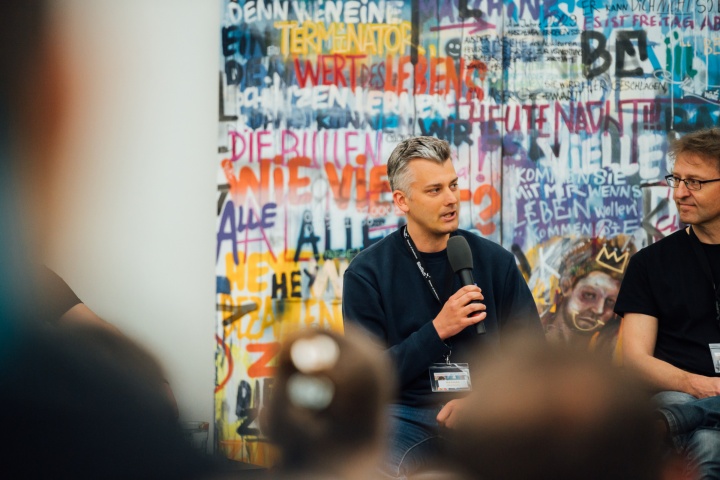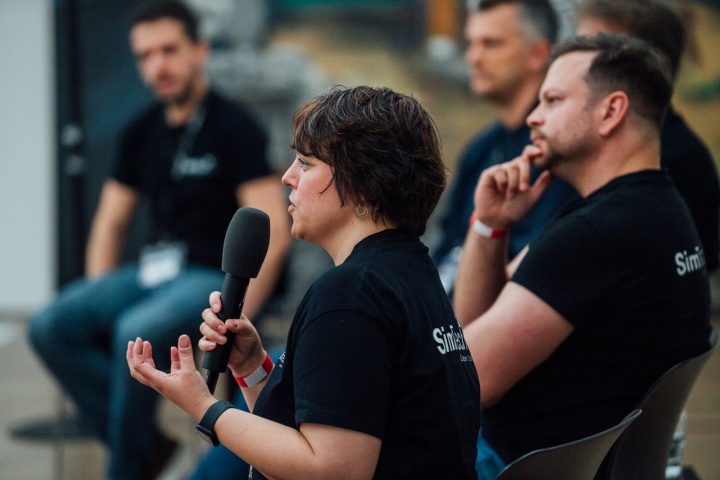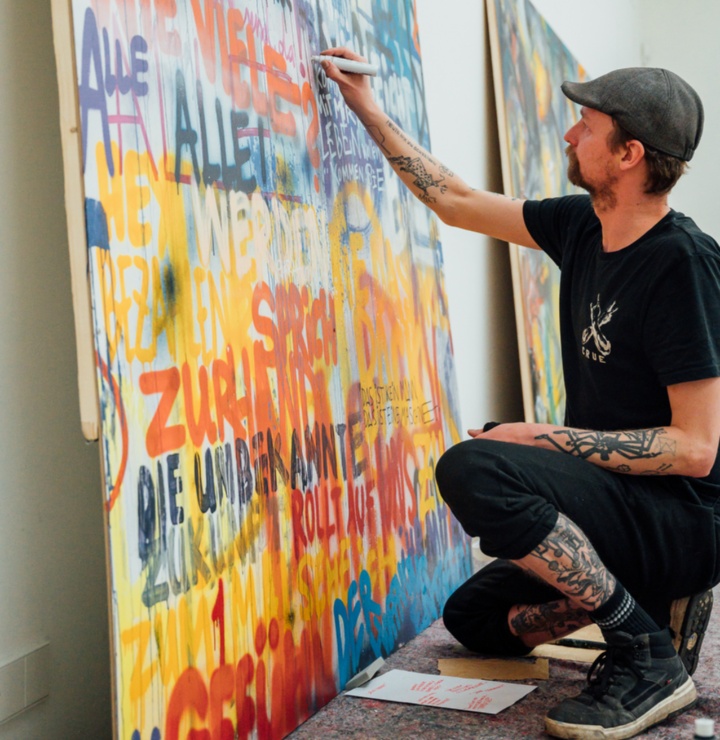The breathtaking progress in the development of artificial intelligence (AI) raises numerous expectations and uncertainties. Dealing with a topic of this magnitude sometimes requires unconventional approaches. At the Science Cypher event held on April 22 at the Kunstmuseum Stuttgart, researchers and graffiti artists discussed the opportunities and limits of AI. The focus was on artworks created in an exchange between scientists and artists. The Science Cypher was a contribution of the Cluster of Excellence “Data-integrated Simulation Science” (SimTech) of the University of Stuttgart to the exhibition “SHIFT. AI and the future community.”
In hip-hop culture, cypher stands for a freestyle in which rappers show off their skills in turn. The title “Science Cypher” was thus a perfect fit for the event at the Kunstmuseum: from the striking graffiti from artist Dingo (@dingobabuschart) that lured curious visitors into the foyer to the informal exchange between researchers, street artists, and visitors to the rap performance at the end.
Large pictures were set up around the podium. These were the results of the creative exploration of topics of the Cluster of Excellence SimTech by street artists. In the run-up to the event, scientists had teamed up with graffiti artists. The results are unusual perspectives on the researchers’ complex questions and exciting exhibits. For example, that of the art–science tandem of Johannes Kässinger, research associate at the Institute for Parallel and Distributed Systems (IPVS) at the University of Stuttgart and artist Joe Fjörgyn (@joefjoergyn). The wired, red and yellow bent arm with flashing fingers was the only sculpture among the pictures. It was inspired by an augmented reality application developed by Kässinger’s team. It represents muscle movements in real time as the researcher demonstrated via tablet. On his monitor, the real image of Fjörgyn’s arm movement was superimposed by a graphically represented contraction of the biceps.
In joint sessions, Fjörgyn had taken a plaster cast of Kässinger’s arm and talked with him about his work. “The sculpture symbolises the effort behind the project, and the cable connection shows a kind of dependency. If we pulled the cable, the additional intelligence in the background would not work,” says Kässinger, who adds: “The process of turning a research topic into a work of art was quite special in itself.”
How is AI research perceived?
With a view to the artworks created, the researchers and artists discussed various issues surrounding AI as well as perspectives on it in science, society, and art.
Prof. Mathias Niepert, head of department at the IPVS and project manager in the SimTech cluster, addresses the question of whether generative Al tools such as ChatGPT and DALL-E are useful or actually dangerous for society. According to Niepert, AI brings both opportunities and risks. Intelligent systems could complement human expertise and help diagnose diseases, among other things. But they could also lead to flawed decisions as well as the easier spread of disinformation and the misuse of data. “It’s important to carefully weigh the opportunities and risks and take precautions in order to develop responsibly,” says Niepert. “Our research is concerned with showing limits to models and making them more predictable and explainable.” This inspired the artist Tao (@tao_artwork) to create an image of a meditating automaton with a heart hovering above its skull and observed by a camera. The image expresses questions such as: “Could AI eventually feel something like emotions? To what extent can these systems be similar to us?” says Niepert. The camera also symbolizes negative aspects – for example, that AI could facilitate surveillance. This illustrates the current area of tension. “How will AI be used in the future? And how will society react to it? These are questions that are open to us experts as well.”
“How do we reclaim our brains from AI?” is the question that sums up the work of graffiti artist Nuri (@nuriliebtfarben), who worked with Dr. Luiz Chamon, junior research group leader in the SimTech cluster and in the ELLIS network: a good-humored Gyro Gearloose wired to a brain taken from a robot. “I am exploring how Al can learn from examples and data while meeting requirements such as robustness, fairness, and security. How can we bring human intelligence into focus and develop AI in a way that suits us?”, says Chamon.
Controlling ships and autonomous cars with AI
Artificial intelligence in locomotion is the topic of Professor Steffen Staab, Co-spokesperson of the Cluster of Excellence, Cyber Valley Professor, Department Head at IPVS and Co-spokesperson of the Stuttgart Research Focus IRIS. For example, how do ships move, and how do they react to internal control and external influences such as waves and wind? Artificial intelligence makes such predictions possible. However, current machine learning systems are still mostly black boxes. “We are investigating how physical models and machine learning can be combined to make predictions about safety,” says Staab. One field of application is autonomous driving. “How can existing knowledge be used to make predictions about traffic situations?” For example, to inform a self-driving vehicle that children are to be expected near a school. The associated graffiti: two metallic feline predator heads showing their fangs. According to graffiti writer Kosmik (@kosmik_one), his association with it was power and machinery combined with organic shapes.
“From this realization, I learn that a certain aggressiveness – perhaps also danger – can also be associated with the subject – even if I don’t make this association myself. That doesn’t exactly help me with my research. But you could think about how it might feel to the audience if we built intelligent systems that automate movement. Is there something that could be threatening for some people?” says Staab.
Artificial intelligence in education
In her work, Maria Wirzberger, junior professor for teaching and learning with intelligent systems at the Institute of Educational Science, spokesperson for the Stuttgart Research Focus IRIS and Researcher in the Cluster of Excellence, focuses on what a person needs in order to learn well. “How can I design technology to best address our needs?” This would require many different disciplines such as educational research, psychology, and computer science to work together. “You first have to know how humans work. For example, the signs such as an accelerated heartbeat that tell me whether someone has to make a special effort when learning. Intelligent systems could respond based on such signs and thus reduce the pace of learning.”
According to Wirzberger, the fact that Punky's (@punkyards) graffiti shows a lot of detail makes it an accurate reflection of the theme of AI in education. “It is a multi-faceted topic that is colorful and new and has a lot of dynamics and potential such as when it comes to helping people in need of support. But there are also challenges such as data protection at different levels”.
“What do we actually want to outsource to AI?”
Critical perspectives on the use of AI became clear – particularly from the ranks of those working in the arts. Artificial intelligence can indeed y complement artistic work – for example, in preparatory sketches for graffiti. But according to graffiti writer Dave (@dosendave), “sometimes the uncomfortable is also necessary in order to be able to move forward.” “After all, there are a lot of things you don’t want to replace, because creating art gives people a sense of purpose. The process of randomness cannot be calculated,” says Fjörgyn. For example, when the wind blows the spray paint and the resulting streaks become part of the work. “You can’t replace the soul and energy of an artist that’s in a piece of work,” sums up Dave.
“We can reach the stars only by taking rocky paths,” says Wirzberger. According to her, in order to connect such fundamental thoughts and research, “we have to think about what we want to outsource in the first place. Where could we lose skills if we outsource them?” She believes that it is a matter of finding smart regulations and emphasizes that “questioning and remaining critical – that is our original human achievement. And we mustn’t lose that.”










